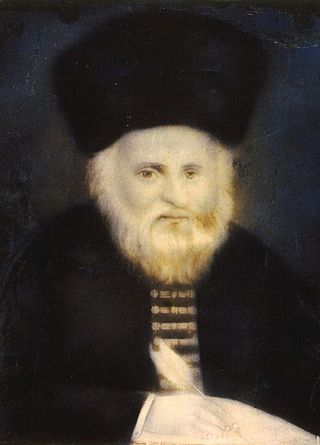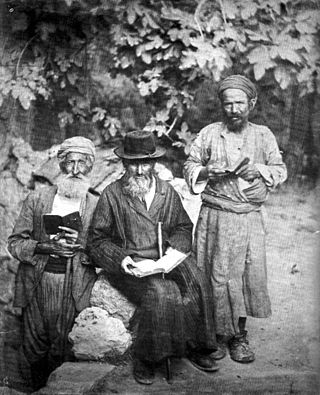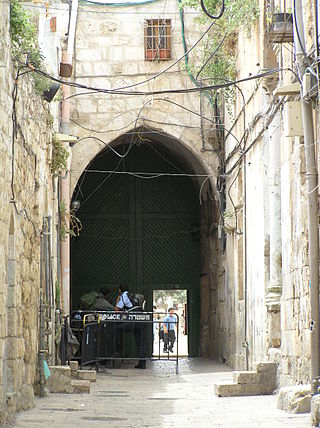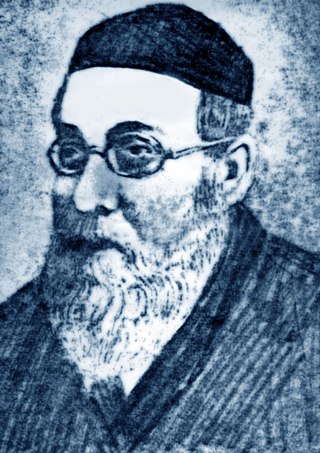This is a list of notable events in the development of Jewish history. All dates are given according to the Common Era, not the Hebrew calendar.

This is a partial timeline of Zionism in the modern era, since the start of the 16th century.

Aliyah is the immigration of Jews from the diaspora to, historically, the geographical Land of Israel, which is in the modern era chiefly represented by the State of Israel. Traditionally described as "the act of going up", moving to the Land of Israel or "making aliyah" is one of the most basic tenets of Zionism. The opposite action—emigration by Jews from the Land of Israel—is referred to in the Hebrew language as yerida. The Law of Return that was passed by the Israeli parliament in 1950 gives all diaspora Jews, as well as their children and grandchildren, the right to relocate to Israel and acquire Israeli citizenship on the basis of connecting to their Jewish identity.

The Hurva Synagogue, also known as Hurvat Rabbi Yehudah he-Hasid, is a synagogue located in the Jewish Quarter of the Old City of Jerusalem.

Elijah ben Solomon Zalman, known as the Vilna Gaon or Elijah of Vilna, or by his Hebrew acronym HaGra, was a Lithuanian Jewish Talmudist, halakhist, kabbalist, and the foremost leader of misnagdic (non-hasidic) Jewry of the past few centuries. He is commonly referred to in Hebrew as ha-Gaon he-Chasid mi-Vilna, "the pious genius from Vilnius".

Judah ben Solomon Chai Alkalai was a Sephardic Jewish rabbi, and one of the influential precursors of modern Zionism along with the Prussian Rabbi Zvi Hirsch Kalischer. Although he was a Sephardic Jew, he played an important role in a process widely attributed to the Ashkenazi Jews. Alkalai became noted through his advocacy in favor of the restoration of the Jews to the Land of Israel. By reason of some of his projects, he may justly be regarded as one of the precursors of the modern Zionists such as Theodor Herzl.
Palestinian Jews or Jewish Palestinians were the Jewish inhabitants of the Palestine region prior to the establishment of the State of Israel in 1948.

The perushim were Jewish disciples of the Vilna Gaon, Elijah ben Solomon Zalman, who left Lithuania at the beginning of the 19th century to settle in the Land of Israel, which was then part of Ottoman Syria under Ottoman rule. They were from the section of the community known as mitnagdim in Lithuania.

The First Aliyah, also known as the agriculture Aliyah, was a major wave of Jewish immigration (aliyah) to Ottoman Syria between 1881 and 1903. Jews who migrated in this wave came mostly from Eastern Europe and from Yemen. An estimated 25,000 Jews immigrated. Many of the European Jewish immigrants during the late 19th-early 20th century period gave up after a few months and went back to their country of origin, often suffering from hunger and disease.

Judah he-Hasid Segal ha-Levi was a Jewish preacher who led the largest organized group of Jewish immigrants to the Land of Israel in the 17th and 18th centuries.
The history of the Jews and Judaism in the Land of Israel is about the history and religion of the Jews, who originated in the Land of Israel, and have maintained physical, cultural, and religious ties to it ever since. First emerging in the later part of the 2nd millennium BCE as an outgrowth of southern Canaanites, the Hebrew Bible claims that a United Israelite monarchy existed starting in the 10th century BCE. The first appearance of the name "Israel" in the non-Biblical historic record is the Egyptian Merneptah Stele, circa 1200 BCE. During biblical times, two kingdoms occupied the highland zone, the Kingdom of Israel (Samaria) in the north, and the Kingdom of Judah in the south. The Kingdom of Israel was conquered by the Neo-Assyrian Empire, and the Kingdom of Judah by the Neo-Babylonian Empire. Initially exiled to Babylon, upon the defeat of the Neo-Babylonian Empire by the Achaemenid Empire under Cyrus the Great, many of the Jewish exiles returned to Jerusalem, building the Second Temple.

Yisroel ben Shmuel Ashkenazi of Shklov was a Lithuanian Jewish Talmudist, one of a group of Talmudical scholars of Shklov who were attracted to Vilna by Rabbi Elijah ben Solomon Zalman, known as the Vilna Gaon (1720–97). He was one of "the last arrivals," and attended upon the Gaon as a disciple for less than a year.

Messianism in Chabad refers to the contested beliefs among members of the Chabad-Lubavitch community—a group within Hasidic Judaism—regarding the Jewish messiah. Many in the Chabad community believe that Rabbi Menachem Mendel Schneerson, the deceased seventh Rebbe of the Chabad-Lubavitch dynasty, is the Jewish messiah. The issue remains controversial within both the Chabad movement and the broader Jewish community.

The Old Yishuv were the Jewish communities of the region of Palestine during the Ottoman period, up to the onset of Zionist aliyah and the consolidation of the New Yishuv by the end of World War I. In the late 19th century, the Old Yishuv comprised 0.3% of the world's Jews, representing 2–5% of the population of the Palestine region.
Avraham Wolfensohn (1783–1855) was a Jewish rabbi, Talmudic judge and leader of the Ashkenazi community in Safed, Ottoman Galilee in the mid-19th century.

Proto-Zionism is a term attributed to the ideas of a group of men deeply affected by the idea of modern nationalism spread in Europe in the 19th century as they sought to establish a Jewish homeland in the Land of Israel. The central activity of these men was between the years 1860 to 1874, before the Zionist movement established practical (1881) and political Zionism (1896). It is for this reason that they are called precursors of Zionism, or proto-Zionists.

Bāb Ḥuṭṭa is a neighborhood in the Muslim Quarter of the Old City of Jerusalem to the north of the Haram al-Sharif. The name literally means "Forgiveness Gate", referring to the Remission Gate of the Haram compound, connected by Bāb Ḥuṭṭa Street.

Nat(h)an Friedland was a rabbi and member of the H'bat Tsion movement, one of the fathers of the movement for settling the Land of Israel. He grew up in Taurig, Lithuania in the early decades of the 19th century and died in Jerusalem in 1883. He became one of the most prolific Zionist writers of the H'bat Tsion movement in the mid-1800s. He was one of several writers and thinkers of the 19th century created the intellectual basis for a new Jewish state. Friedland's collected writings, including his most popular work, "Der Cos", were translated from the Yiddish to modern Hebrew. All these publications are in Hebrew except the Jewish Encyclopedia article which is in English.

Yosef Yitzhak "Yoshya" Rivlin was an Orthodox Jewish scholar, writer, and community leader in the Old Yishuv of Jerusalem. Scion of a family of Perushim, disciples of the Vilna Gaon who immigrated to Israel in the early 19th century, Rivlin spearheaded the establishment of the first Jewish neighborhoods outside the Old City walls. He helped found a total of 13 neighborhoods, beginning with Nahalat Shiv'a and Mea Shearim. His activities earned him the nickname Shtetlmacher ("Town-Maker"). He directed the Central Committee of Knesseth Israel, the supreme council of the Ashkenazi community in the Old Yishuv, for over 30 years.













